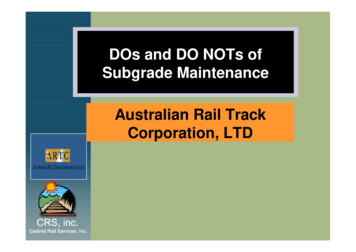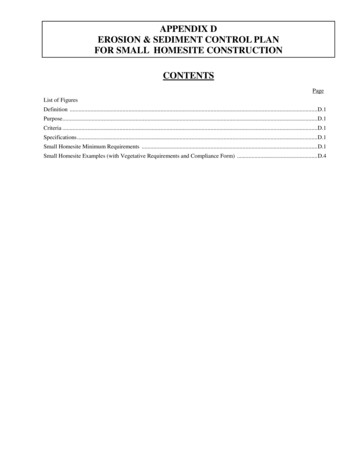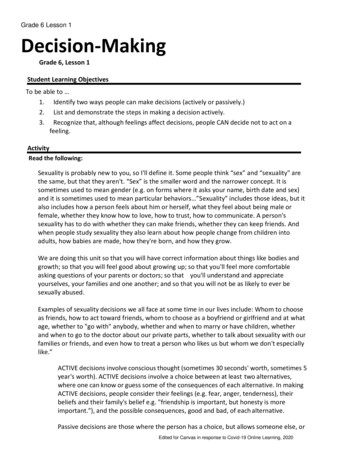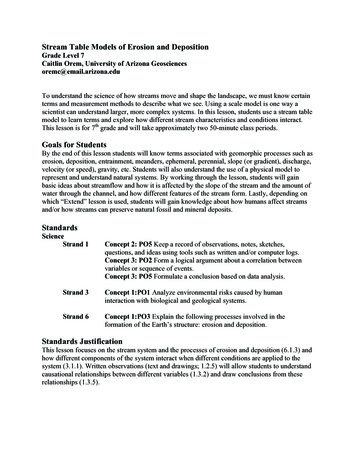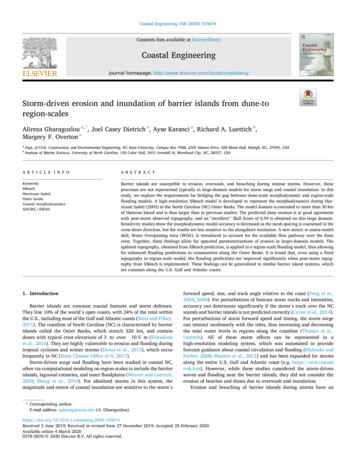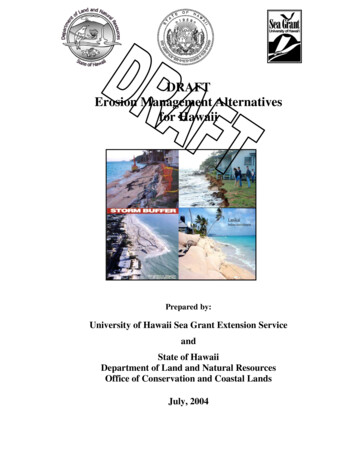
Transcription
DRAFTErosion Management Alternativesfor HawaiiPrepared by:University of Hawaii Sea Grant Extension ServiceandState of HawaiiDepartment of Land and Natural ResourcesOffice of Conservation and Coastal LandsJuly, 2004
Jurisdiction Hawaii Revised Statutes 205A-1The State of Hawaii defines the shoreline for purposes of jurisdiction and propertyboundaries as " the upper reaches of the wash of the waves, other than storm or seismic waves,at the highest tide during the season of the year in which the highest wash of the waves occurs,usually evidenced by the edge of the vegetation growth, or the upper limit of debris left by thewash of the waves." By this definition, "the beach" may be loosely defined as the sandy areafrom the high wash of the waves to the seaward edge of the foreshore. Similarly, cliffs, dunes orother features landward of the backshore may be defined simply as "coastal" features or uplands.Common shoreline and beach terminology is listed below.Shoreline Terminology(Image: John Wiley and Sons)In Hawaii, each county defines unique zoning andsetback regulations for coastal development based onthe position of the certified shoreline. Most (not all)counties apply a minimum 40 foot setback zone fromthe certified shoreline where development is prohibited.Maui County is in the process of revising theirshoreline setback laws to a variable set back based onthe annual rate of erosion. Generally the state isresponsible for regulation of the area from the shorelineseaward to the 3-mile offshore limit of the state'sjurisdiction, this is often referred to as the ConservationDistrict.Likewise, each county regulates the areafrom the shoreline landward in a Special ManagementArea (SMA). Both the Conservation District and theSMA have restrictions on the type of activities that areallowed within this area.Coastal Jurisdiction -LanikaiDRAFT:Erosion Management Alternatives for Hawaii.Revised: July, 2004Page 3 of 6
Seasonal ChangesMany coastal residents are acutely familiar with the seasonal changes that occur alongtheir particular shoreline. The seasonal changes in Hawaii can be quite dramatic and are a resultin the seasonal shift in the wave regime. Large North Pacific Storms dominate in the winterwhile Southern Hemisphere swells and short period trade wind swell are more typical in thesummer. The change in direction and energy cause the beach to change shape either through thelongshore or cross shore transfer of sand.Hawaii’s waves originate from four primary sources, North Pacific swell, northeast tradewind swell, south swell, and Kona storm swell. Hurricanes and tropical storms are alsoimportant sources of waves that impact Hawaii’s coasts on an interannual basis. Short-waveperiod Kona storms and hurricanes often have a severe erosional effect on the south-facingshores of the Hawaiian Islands. These episodic storms have been found to one of the primarycauses of beach loss in some areas of Kaanapali, West Maui (Eversole, 2002)From: Atlas of Natural Hazards in the Hawaiian Coastal Zone 2002DRAFT:Erosion Management Alternatives for Hawaii.Revised: July, 2004Page 4 of 6
Seasonal fluctuations in the shape of the beachare often somewhat predictable and should becarefully considered while planning any erosioncontrol procedures. Coastal homeowners shouldbe familiar with these seasonal fluctuations andbe prepared to anticipate erosion and beach lossissues. Coastal homeowners on north facingshores should pay particular attention to theseasonal changes of the shoreline due to highsurf in the winters. Often what appears to besignificant beach loss may be normal seasonaladjustment that will recover quite rapidly withthe change in the wave regime. Severe coastalerosion and beach loss is sometimes due to acombination of chronic erosion compounded byseasonal beach loss or an unusually large eventor series of events that erode beyond the normalseasonal adjustment range.(See SheratonKaanapali steel sheets in the following Section).If historical aerial photographs are used toestimate an erosion rate based on the position ofthe shoreline an assessment of the seasonal errordue to seasonal changes should be applied thustaking into account the season in which thephoto was taken. For example, the beach atHanakoo Point in Kaanapali Beach reveals a strong seasonal fluctuation of up to 60 meters withfairly predictable regularity. A historical shoreline analysis carried out with aerial photographsmust take into account the magnitude of these seasonal fluctuations in order to accurately assessthe long-term trend of the shoreline.Seasonal Change at Kaanapali BeachJune, 2000January, 2001July, 2003DRAFT:Erosion Management Alternatives for Hawaii.Revised: July, 2004Page 5 of 6
a) Coastal Dune Stabilization, Restoration and VegetationSand dunes play an important part in the beach system. Vegetated dunes trap windblownsand, store excess sand reserves, serve as natural erosion buffers and create an elevated berm anddense root system that may protect against storm and high wave events. The dunes provide anemergency supply of sand to the beach when erosion occurs. It is advisable to plant species thatare adapted to the physical and chemical characteristics of the site, maybe with some advice froma professional or nursery. Several species of native Hawaiian plants are adapted to the coastalenvironment and perform well for erosion control.'Aki 'AkiPohuehue (Beach Morning Glory)'AkulikuliSea Shore Paspalum GrassNaupakaWind Breaks & Walk OverThese salt-tolerant species of plants and grasses provide a effective erosion control forHawaii dune systems. Natural vegetation is important for stabilizing the dune system. Theselow-lying plants work well to cover the active dune and protect the backshore against temporaryerosion by forming a dense mat that is resistant to wind and wave erosion. Seashore Paspalumgrass is ideally suited for Hawaii in the area behind the frontal dune but still in the erosion zone.This salt tolerant grass can grow directly on the sand with little or no soil needed. It canwithstand periodic flooding and can be irrigated with brackish water. As with many of thesespecies herbicides are not needed because salt water can be used to kill weeds. Dune walk oversand wind breaks also help to prevent erosion to the dune system and should be considered inareas where heavy foot traffic and wind is causing erosion of a dune. Pathways that crossthrough a dune should be oriented diagonally to the predominant wind direction so that thepathway does not allow wind blown sand to be funneled through the depressed pathway.DRAFT:Erosion Management Alternatives for Hawaii.Revised: July, 2004Page 6 of 6
Advantages: Low cost and aesthetically pleasing natural alternative that is relatively easy toachieve. Helps retain natural appearance and provides habitat for many native species of plantsand animals. Trees act as wind breaks while low lying plants and grasses that have dense rootsystems perform well as erosion control.Disadvantages: Few vegetation speciescan survive repeated inundation by saltwater.Takes considerable time toestablish dense vegetation that is resistantenough to withstand large storms andplanted areas are vulnerable to erosionuntil vegetation is well established. Notas effective against wave erosion as othermeasures. Requires periodic maintenanceand watering. If vegetation encroachesonto state land can complicate theshoreline certification process and can beintrepreted to be an encroachment ontostate lands.Seashore Paspalum grass is ideally suited for the areabehind the frontal dune and can grow directly on the sandwith little or no soil.Costs: Low cost alternative. Cheapest ofthe erosion control measures.Costdepends on landscaping style and vegetation choice.Permits Required: Special Management Area (SMA) PermitCoastal vegetation at Kailua Beach,Oahu. Naupaka (right), Beach MorningGlory (Left-Center) and Aki Aki (Left)providing a protective mat on the coastaldune.DRAFT:Erosion Management Alternatives for Hawaii.Revised: July, 2004Page 7 of 6
Dune walk overs and wind breaks also help to prevent erosion to the dune system and should be considered in areas where heavy foot traffic and wind is causing erosion of a dune. Pathways that cross through a dune should be oriented diagonally to the predominant wind direction so that the
